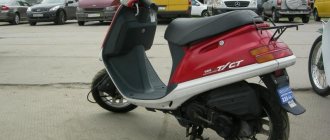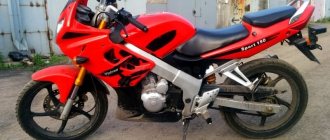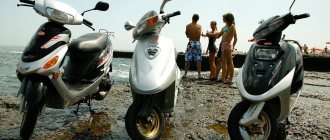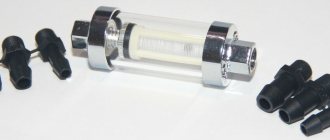Qualitative indicators
The main technical characteristics of the Honda Dio are presented using the example of the AF 27 model:
| Parameters (length; width; height) | 167.5 cm; 63 cm; 99.5 cm |
| Weight | 69 kg |
| Speed | Maximum 60 km per hour |
| Tank volume (fuel; oil) | 5 l; 1.3 l |
| Load capacity | 150 kg |
| Engine | Two-stroke, variable speed with forced air cooling |
| Engine model | AF 34 E |
| Fuel consumption per 100 kilometers | 1.85 l |
| Engine capacity | 49.9 sq. cm |
| Start | Electric/kickstarter |
| Piston parameters (stroke; diameter) | 3.93 cm; 4 cm |
| Engine power | Maximum 7 horsepower (6500 rpm) |
| Chassis (brake; wheels) | Drum; 3.00-10 |
| Suspensions (front; rear) | Telescopic fork; spring shock absorber |
The entire range of Dio scooters has almost the same load capacity, speed, starting, two-stroke engine and suspension. Brakes may vary - some models have disc brakes on 1 or 2 wheels.
Test Drive
The Honda Dio scooter is undoubtedly endowed with considerable benefits and amenities that come in handy, especially for newly converted scooter riders. The main advantages of this vehicle include:
- speed allows you to be universal for any road;
- quite rigid frame;
- light weight, handling and excellent dynamics save the rider from unforeseen surprises;
- wear-resistant engine;
- ratio of quality and cost;
- perfect plastic, perfectly fitted at the joints;
- there is a 2nd passenger seat;
- dimensions;
- convenient trunk hidden under the seat;
- luggage hook;
- pocket immediately under the steering wheel;
- trendy design and streamlined shapes;
Photo of Honda Dio AF 34CESTA
More serious representatives, such as Dio AF 34 and 35 ZX, have the capabilities to participate in racing, and the memorable appearance will not leave any true connoisseur of motorcycle technology indifferent. Models are found in restyling, in ABS modifications, which adds extra gas shock absorbers, crystal optics, a powerful engine and alloy wheels. Some are equipped with front baskets. The AF 35 ZX model is amazingly good - this white beauty is simply mesmerizing during sharp starting jerks from traffic lights.
We detect inconveniences
Any thing in use by humanity is, as a rule, imperfect. Honda Dio scooters also have some disadvantages:
- due to high demand, difficulty in purchasing;
- not suitable for winter trips;
- rather expensive service station;
- low ground clearance (between the road and the frame);
- fans of scooter racing are not satisfied with the speed offered;
Historical facts
The Honda-Dio family first saw the light back in 1988. All models in the series are known to customers as reliable, compact, and maneuverable. In addition, they are easy to improve (tuning).
The first generation came out in the late eighties. There are currently six of them:
- First generation (since 1988) marked AF-18/25.
- The second appeared in the early nineties. The markings of the models of these years are AF-27/28.
- The third appeared in 1994. This was the Honda Dio AF 34, the characteristics of which we will consider below. In addition to this version, there was another one labeled AF-35.
- The fourth generation, which appeared in 2001, was called “Smart-Dio” and had the indexes AF-56/57/63.
- "New Dio" belongs to the fifth generation, which began to be produced in the fall of 2003. The models were marked as AF-62/68.
- The sixth, and currently last, generation was presented to the public in the summer of 2014. It was called "Dio-Deluxe-100" or JF-31.
The peculiarity of the latest models is that they belong to a different class. These are already scooters that can carry, in addition to the driver, also a passenger. Their characteristics have changed so that the power of the power unit is sufficient for increased load capacity.
Repair instructions for Honda Dio
Tips for repairing Honda Dio are available to any motorcycle enthusiast. In particular, we will talk about servicing the vital parts of an iron car: engine, carburetor and transmission.
The carburetor is a sensitive and important part of the scooter. The slightest breakdown will stop the operation of the entire machine. Owners are often afraid to touch carburetors because they are not confident that they can assemble them correctly. However, everything is not as scary as it seems at first glance. Honda Dio is recognized by experts as the most convenient and suitable representative for disassembling and cleaning the carburetor. The fact that it is not covered with plastic, its location above the transmission and the ease of setting up the mechanism speak in its favor.
A few recommendations:
- the adjustment process is carried out on a well-warmed engine;
- if there is any doubt about a blockage, clean the carburetor and rinse thoroughly;
The setting itself involves adjustment:
- idle move;
- quality of the mixture (by moving the needle and using;
- specialized screw;
- amount of fuel in the float chamber;
Honda Dio engine repair
The engine is the heart of the scooter. Principles for eliminating basic breakdowns:
- piston wear and increasing fuel and lubricant consumption are caused by low compression (below 8.0 kg/cm3 with a norm of 9.5-10.5); it is necessary to bore or change the cylinder-piston group;
- a clear and loud knocking sound at the bottom of the cylinder, often when throttling, indicates wear of the piston skirt—replace the piston or the entire c/p group;
- the engine stalls, losing power, usually when it is clogged - cleaning is required: burn it, or cut it, clean off the carbon deposits and weld again; the exhaust window can be cleaned;
- does not start, does not work well, does not hold idle speed if the seals are broken (fuel leaks form there) of the cylinder, crankcase, head gasket, crankshaft seals are worn out - replace the seals and gaskets;
The transmission also becomes unusable, and, sooner or later, it is replaced. The process of replacing the variator is not particularly difficult. The main thing is to choose the right belt - this will allow you to keep its settings unchanged. For example, a very long belt will begin to slip, and a wide one will reduce the range of gear ratios and will not reach the maximum width of the cones.
Recommended variant belt sizes
| Models | Dimension in mm |
| AF18; SR AF25, 28; AF27, 34, 35; Fit AF27; XR AF27; | 15-650 |
| Smart Dio: AF56, DX AF57; Z4 AF57 | 17,7-670 |
| ZX AF28 | 18-662 |
| ZX AF35 | 18-667 |
Main features of the scooter
If the second generation of the Honda-Dio series was more like a restyled version, then the Honda Dio AF 34 is a completely new model. It attracts attention with its beautiful design and sophisticated elegance. The first impression is supported by technical characteristics that make you fall in love with this scooter.
With a relatively light weight (seventy kilograms), the scooter rides quickly and has a high degree of maneuverability. This makes it perfect for city driving. It moves easily and skillfully even between cars stuck in traffic jams.
The Honda Dio AF 34 scooter was produced in several versions. For example, the restyled model, which appeared in 1998, had better technical performance (improved engine and muffler), transparent front optics, and alloy wheel rims. The presence of several design options allows the buyer to choose the most suitable parameters for him.
Thanks to the horizontal arrangement of the engine cylinders, the trunk located under the saddle has a flat floor. The scooter was decorated in a style that was fashionable at that time. Over time, the design has changed slightly. The alterations affected the optics, and curtains appeared to protect the central locking. The most popular versions were sometimes produced in limited editions. They were timed to coincide with the most important events for the company.
As for repairs, everything is simple. As with other products from Japan, the Honda Dio AF 34 does not have any difficulties with disassembling and replacing parts. Spare parts can be easily purchased; they are available for free sale.
The difference between Honda GBL and GBLK engines
All photos in this article are used from the Internet. May the authors of these photographs forgive me (which I ruined with my squares), but their photographic material will greatly help someone (well, I hope), so let’s begin...
In the first article, I wrote about the need to purchase spare parts for the engine of my Dio 34 Cesta, fortunately there are no problems with the availability of various spare parts on sale, but there are nuances when choosing them based on the modification of the engine. Let's look at the most common ones.
Honda Dio 34/35/ZX was produced with a two-stroke AF34E engine, which had two modifications - GBL(A) and GBLK. In the assembled state (when everything attached to the motor is installed) it is almost impossible to distinguish them. But the very first and very noticeable difference is the intake manifold (it is clearly visible on the engine). The GBL version has 4 bolts, and the GBLK version has 3, so the seats on the crankcases are different.
It is also noticeable that the crankcase halves are different. They have reinforcing partitions arranged differently, and in the GBL engine the front part of the crankcase is more rounded (in the GBLK it seems to go to an angle). In addition, the seats for the crankshaft bearings are different in the crankcase halves (large and small), in GBLK it is 52 mm, in GBL it is 56 mm (extremely rare, but 52 mm have also come across). The oil pump mountings also differ. The GBL motor has all switches with 2 chips (CI649A or CI649), while the GBLK has 1 chip (CI694).
The inlet channel of the reed valve of the GBLK motor is smaller than that of the GBL; additional partitions in the GBLK interfere with the flow of air and “strangle” the motor. Along with the difference in carburetors and the difference in the volume of chambers in the crankcases, this determines the difference in power of the standard engine declared by the manufacturer for the GBL of about 7.2 hp, GBLK - 5.6 hp.
Lobe boring DIO AF-35 GBLK
Objectively: the stock Honda Dio 35 ZX cannot have more power than the GBL engine on the same Dio 34. Well, the speed of the 35 ZX is higher due to the difference in carburetors, belt and variators. The 35 ZX has a carburetor with a large intake duct (coming from the air filter) and a large air damper “bowl” (about 18 mm versus 14 mm for the carburetor version with an aluminum damper and 16 mm for the version with a plastic damper). The front variator of the 35 ZX has longer guides, which allows the variator rollers (standard 8.5 degrees for both engines) to extend further than a simple Dio 34/35, which means the belt can reach a larger radius of the front variator. The rear variator has pulleys of increased diameter - 118.5 mm versus 106 mm for the standard. The torque driver travel for the 35 ZX is 15.3 mm versus 13.5 mm for the standard. Along with the large pulleys, the variator bushings are also different: the 35 ZX has a length of 36.2 mm, the Dio 34/35 has a length of 33 mm. All this allows you to install a longer and wider belt: for 35 ZX - 667 * 18 mm, for Dio 34/35 - 650 * 15.5 mm.
The variator covers for the GBL(A) and GBLK engines are also different.
The GBL cover has more fasteners. The GBL has an additional cup that stands under the variator cover and protects the bendix from waste flying from the variator belt; the GBLK does not have such a cup at all, and the bendix is inserted into the seat of the variator cover itself (there is a small bushing there). The GBL cover has an overhead sealing gasket, which can be either made of paronite or cardboard, or rubber with a fastening ring for the carburetor drain pipe, and the GBLK has a special channel in the lid into which a rubber gasket in the form of a cord (having a T-shaped cross-section) is inserted ). Well, accordingly, the places where they adjoin the crankcases repeat their contour (either more round, or at an angle). By the way, it is very difficult to find a variator cover (either of the two) that is not worn from the winding stem separately, and the price sometimes reaches up to 6.5 thousand rubles. for the cover assembly with the gasket, not killed by the winding mechanism and the leg.
The GBLK crankshaft cheeks are wider than the GBL, so purchase the crankshaft carefully. If you put a wide crankshaft on a GBL engine, you can manage to break out the seats in the crankcases. The crankshaft bearings for GBL are larger - 56 * 20 * 12 mm, and for GBLK - 52 * 20 * 12 mm. The GBL engine had iron variator pulleys, while the GBLK had iron and aluminum pulleys (they “spin” easier, but wear out faster). The GBL (and some GBLKs too) has a 3-pad clutch, while most GBLKs have a 2-pad clutch.
In GBL, the cylinder head is designed for 2 bolts for attaching the blower (cooling) casing, in GBLK it is designed for one, and accordingly, the number of holes on the casing itself is different.
On some GBLK engines (GBL didn’t seem to have one at all), and on versions of the carb without an electric valve, there was such a “stray” in the air filter. This is a kind of valve (membrane), which, under the influence of temperature differences, should have supplied more or less air to the carburetor (opened/closed). In reality, this is a rare “game”, which simply does not really cause a lot of hemorrhoids, because... Some kind of dirt always forms in the air filter and fine dust still gets into the mechanism and quickly disrupts its normal functioning...
Well, mufflers:
The GBL had 2 mufflers: a regular muffler or ZX chrome, and the GBLK had 2 mufflers: a regular muffler and a muffler with catalytic converter.
In conclusion, you can note that the Japanese began to save on the GBLK engine: there is no Bendix protective cup, a simpler intake manifold (3 bolts and no separate ebb for attaching the rear wing), no second cylinder head air cover mount, fewer mounts on the variator cover, less bearing size, clutch has fewer pads, etc.
In general, I hope this article was useful for readers, and will help someone choose the right spare parts based on the visualization of the differences presented here, especially when the search for spare parts takes place at “disassembly” and often does not have a proper description.
Tags
- Honda
- Dio
- GBL
- GBLK
- AF34E
Basic indicators
The described scooter model has a length of 1,675 millimeters, a width of 630 millimeters and a height of 995 millimeters. The seat height is seven hundred millimeters. The clearance to the road is almost one hundred and five millimeters. Moreover, its weight, as mentioned above, is 69 kilograms. Honda Dio AF 34 – single seater. But its carrying capacity is one hundred and fifty kilograms.
For a hundred kilometers the scooter consumes 1.85 liters. The fuel tank has a volume of five liters. And the capacity of the oil tank is 1.3 liters. Technical components allow you to accelerate to sixty kilometers per hour. But there were cases when owners reached speeds ten or even fifteen kilometers per hour higher. Therefore, we can say that the maximum speed declared by the manufacturer is not an insurmountable value.











